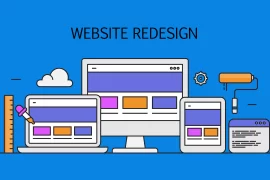Redesigning a website may be beneficial in terms of increasing the user experience, upgrading your online presence, and maintaining your position in the competitive landscape. If a deliberate approach is not taken, however, they have the potential to be both expensive and disruptive. It is important to keep the following advice in mind while redesigning your website so that you may save money and assure its success:
Establish Very Specific Goals and Objectives:
Define precise, quantifiable goals for your redesign, such as raising conversion rates, improving site performance, or improving mobile responsiveness. – Your redesign should focus on improving the user experience for mobile devices. Having well-defined goals can help direct your decisions at every stage of the process.
“User-Centric Design,” often known as “UCD”
Make improving the user experience (UX) a top priority by carrying out user research in the form of surveys and usability testing. If you want to build a design that will resonate with your target audience, you need to understand their wants and preferences.
Adaptive or Responsive Design
Make sure that your new website is optimized for mobile devices and has a responsive design. This is absolutely necessary in order to keep and get new visitors to your website given the growing amount of consumers who access websites using mobile devices.
Things to Consider Regarding SEO
Search engine optimization (SEO) is something that should not be ignored. Conducting keyword research, adjusting site structure, and producing content that is favorable to SEO should all be part of your initial planning for search engine optimization (SEO). Ensure that the old URLs are properly redirected.
Strategy for the Content
Create a content plan that is in line with your brand and the goals you want to achieve. It is crucial to have material that is both of high quality and entertaining in order to attract and keep visitors. Examine the already available material to ensure that it is accurate and still relevant, and then update it.
Optimizing Your Work’s Performance
Increasing user happiness and lowering bounce rates may be accomplished through optimization of the site’s speed and performance. To decrease the amount of time it takes for pages to load, compress the pictures, simplify the code, and make use of content delivery networks (CDNs).
Test and Iterate
Before releasing the new website to the public, you should carry out exhaustive testing to locate and address any problems that may have been introduced. Testing using A/B may help optimize design components and content to ensure they have the greatest possible impact.
Backup and Safety Measures
Make sure that there are backups of the data in order to avoid losing any data during the changeover. Put in place strong security measures to defend against the risks posed by cyberattacks and data breaches.
Financial Plan and Timetable
Create a timetable and a budget for the project that are based on reality. Unanticipated delays or budget overruns can be financially burdensome and emotionally draining.
Collaboration with the Team
Encourage productive cooperation among the members of your project team, which should include designers, developers, content providers, and stakeholders. It is crucial to have both clear communication and a shared vision.
Migrate With Caution
If you are moving from an existing website, make sure the move goes as smoothly as possible. It is important to preserve your SEO rankings and prevent broken links, therefore you should redirect old URLs to their new equivalents.
The feedback mechanism is as follows
Implementing a feedback system to collect user thoughts and reports of bugs should be done after the introduction of the product. This will assist you in swiftly identifying and addressing any problems that may arise.
Analyses and Observations
After the website has been launched, you should install website analytics tools in order to track traffic, user activity, and conversion rates. Utilize these facts to build enhancements that are data-driven.
Instruction and Record-Keeping
Educate your staff on how to use the content management system (CMS) that was installed on the new website. It is important to document all of your processes and procedures to make continuing maintenance easier.
Continual Improvement
A website is not a fixed thing; rather, it should develop over the course of its existence. In order to maintain the usefulness and relevance of your website, you should continually seek feedback, examine data, and make modifications.
By adhering to these best practices and incorporating the appropriate specialists in the project of redesigning your website, you can reduce the likelihood of making costly mistakes and increase the likelihood that your new website will achieve your goals and go above and beyond the expectations of your users.

Leave a Reply Cancel reply